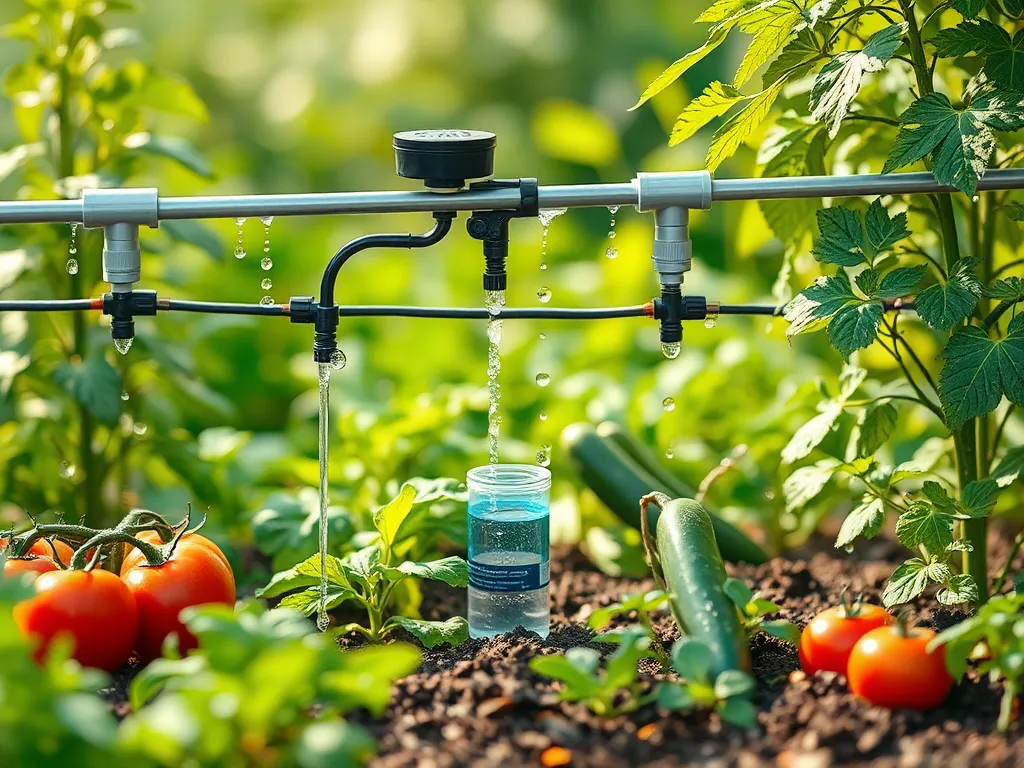Expert Guide: Create a Water-Efficient Drip Irrigation System

The Essential Guide to Drip Irrigation System
The Drip Irrigation System is a method that delivers water directly to the base of plants, minimizing evaporation and runoff, making it an efficient watering technology. By using a network of tubing, emitters, and valves, this method ensures that plants receive the right amount of water tailored to their individual needs, promoting healthier growth and reducing water wastage.
One of the main advantages of a Drip Irrigation System is its ability to conserve water, which is crucial in regions experiencing drought and water scarcity. This system allows for precise watering, targeting the root zone of plants and significantly reducing the amount of water lost to evaporation. As farmers and gardeners face increasing pressures to be more sustainable, drip irrigation has become an essential tool in modern agriculture.
Moreover, the Drip Irrigation System helps prevent numerous issues associated with overwatering, such as disease and nutrient leaching. By providing a consistent moisture level, it encourages healthy root development and improves crop yields. Furthermore, with the ability to automate watering schedules, farmers can save time and labor while ensuring optimal irrigation practices.
Our comprehensive guide on Water conservation techniques can help you save water and money.
In addition to traditional agriculture, the Drip Irrigation System is widely used in landscaping, gardens, and greenhouses. This versatility makes it an excellent choice for any type of cultivation. Whether you are a large-scale farmer or a part-time gardener, this system can be adapted to meet your specific needs.
Check out our tutorial on how to create a DIY drip system for your garden.
With its combination of efficiency, water conservation, and versatility, the Drip Irrigation System is a technology that not only supports sustainable agriculture but also contributes significantly to resource management in an increasingly water-scarce world.
Understanding Drip Irrigation
Drip irrigation is an innovative watering technique that involves delivering water directly to the roots of plants through a system of tubing, valves, and emitters. The system operates by allowing water to drip slowly from the emitters, which are positioned at the plant’s root zone. This method minimizes water waste and maximizes plant intake, making it an ideal solution for regions with limited water supply.
The advantages of using drip irrigation are especially evident in arid climates where water conservation is paramount. The system reduces evaporation and runoff by ensuring that water penetrates the soil exactly where it is needed. By maintaining a consistent moisture level, it also helps to enhance the growth and development of plants while decreasing the likelihood of diseases caused by excessive water exposure.
When comparing drip irrigation to traditional irrigation methods, such as flood or overhead irrigation, drip systems emerge as the more efficient choice. Traditional methods often lead to water-loss through evaporation and runoff, particularly during the hotter months. In contrast, drip irrigation directs water into the soil, ensuring that every drop is utilized effectively by the plants, thereby enhancing preservation efforts.
To learn more about Efficient watering methods, visit our latest article.
Designing Your Drip Irrigation System
Designing a drip irrigation system starts with determining the layout that best suits your garden or farm. Factors such as plant placement, soil type, and topography must be considered. Efficient system design will ensure optimal water delivery and coverage to all plants, promoting healthy growth and minimizing water waste.
Selecting appropriate drip irrigation components is crucial to the overall effectiveness of your system. Components include drip tubing, emitters, filters, and pressure regulators. Each of these elements plays a vital role in the operation of the drip system and choosing quality components will ensure longevity and efficiency.
Calculating water flow rates is also an essential part of system design. By determining the water needs of your plants, you can adjust the flow rates and schedule of irrigation accordingly. This ensures that each plant receives the right amount of water without overexerting your resources.
Installation of Drip Irrigation
Installing a drip irrigation system can be a straightforward process when following a step-by-step guide. Start by preparing the distribution layout according to your design plan. Then, lay out the mainline tubing and connect emitters at calculated intervals. Turn on the system to flush out debris, check for leaks, and make necessary adjustments to ensure an efficient operation.
Common mistakes during installation include misplacing emitters or failing to account for pressure variations. To avoid these issues, ensure that your measurements are accurate and consult with irrigation professionals if needed. Proper planning and careful execution will lead to a successful installation.
After installation, testing and adjusting your system is crucial for optimal function. Regularly monitor emitter output and check for clogs. Adjust the schedule and flow rates based on plant growth stages and seasonal changes to maintain efficiency and prevent under or over-watering.
Maintenance of Drip Irrigation Systems
Routine maintenance tasks are essential for the longevity of your drip irrigation system. Check for clogs in emitters regularly, clean filters, and ensure that all components are functioning correctly. Scheduled maintenance will help prevent major issues and maintain efficient water delivery.
Troubleshooting common problems in drip irrigation involves identifying leaks, clogs, and uneven watering. Pay close attention to areas of your garden that may be under or overwatered and take necessary corrective actions. This might include replacing faulty components or adjusting watering schedules.
Seasonal checks and preparations for your system are crucial, particularly before the growing season. This includes flushing the system to remove debris, checking for damage incurred over winter, and ensuring that all components are in good working condition. Regular maintenance and preparations will ensure your system runs efficiently year-round.
Water Conservation Techniques
Drip irrigation promotes water conservation by directing water specifically to the plant roots, minimizing waste. This efficient method allows for the precise amount of water to be delivered based on current needs, which is especially important in conservation-focused agricultural practices.
Pairing mulch and other gardening techniques with drip irrigation can further enhance efficiency. Mulching helps retain moisture, reduces evaporation, and suppresses weed growth, creating an optimal environment for your plants. Combining these techniques results in superior plant health and reduced water requirements.
Understanding local water restrictions and regulations is essential when implementing a drip irrigation system. Always stay informed about local guidelines, as this can impact your watering schedule, and ensure your practices align with conservation efforts in your community.
Choosing the Right Plants for Drip Irrigation
When selecting plants for a drip irrigation system, consider incorporating drought-resistant varieties that thrive in your local conditions. In regions like Phoenix, plants such as succulents and native shrubs will maximize the efficiency of water use and provide vibrant landscaping with minimal water consumption.
Group plants based on their water needs to optimize the benefit of your drip irrigation system. Plants requiring similar moisture levels can be placed together, allowing for targeted watering while preventing over or under watering of specific plants.
Plant selection dramatically impacts irrigation efficiency. Choosing compatible plants can not only enhance visual appeal but also promote healthier growth and lower overall water usage, effectively integrating landscape design with smart irrigation techniques.
Advanced Techniques and Technologies
Smart irrigation controllers offer numerous benefits, including programmable schedules that adjust according to weather patterns and soil moisture levels. These advancements help conserve water and automate the irrigation process, allowing gardeners to achieve efficiency without constant manual intervention.
Integrating rainwater harvesting systems with drip irrigation can significantly reduce dependency on municipal water supplies. By collecting and using rainwater for irrigation, you can help sustain your landscape while promoting environmental sustainability.
Using sensors to optimize water delivery ensures that plants receive the right amount of hydration without waste. Sensors can monitor soil moisture levels and automatically adjust the irrigation schedule, making it easier to maintain the health of your garden or farm.
